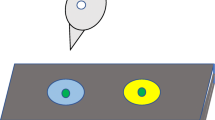This article describes an original method for studying the physiological mechanisms of food preference. The method can be used to study the selective role of visual and orosensory food-related stimuli in the selection of the preferred food and to model the processes forming food and drug dependence in animal experiments. The role of fractional food reinforcement in the formation of ongoing motivation and food preference is discussed.
Similar content being viewed by others
References
S. V. Al’bertin, “Involvement of the dopamine-reactive system of the caudate nucleus in the regulation of operant conditioned reflexes with different levels of complexity,” Ros. Fiziol. Zh., 71, No. 1, 87–94 (1985).
S. V. Al’bertin, “Involvement of the nucleus accumbens in forming spatial selection reactions in rats in a radial maze,” Ros. Fiziol. Zh., 88, No. 5, 545–552 (2002).
S. V. Al’bertin, Patent No. 2520154 RF, “An apparatus for studying feeding behavior in animal experiments,” Byull. Izobret., No. 127 (2014).
S. V. Al’bertin, “Effects of the reinforcement regime on food preference,” Donozol. Zdorov. Obraz Zhizni, 2, 85–89 (2013).
S. V. Al’bertin, “Effects of reinforcement regime on the formation of food preference in rats,” in: Basic Sciences – Medicine, Belaruskaya Navuka, Minsk (2013), Pt. 1, pp. 28–32.
S. V. Al’bertin and S. I. Wiener, “Neuronal activity in the nucleus accumbens and hippocampus in rats on formation of seeking behavior in a radial maze,” Byull. Eksperim. Biol. Med., 18, No. 10, 400–405 (2014).
S. V. Albertin, A. B. Mulder, E. Tabuchi, et al., “Lesions of the medial shell of the nucleus accumbens impair rats in finding larger rewards but spare reward-seeking behavior,” Behav. Brain Res., 117, 173–183 (2000).
E. J. Capaldi, D. J. Miller, and S. Alptekin, “Multiple-food-unit incentive effect: nonconservation of weight of food reward by rats,” J. Exp. Psychol. Anim. Beh. Proc., 15, No. 1, 75–80 (1989).
A. M. Dossat, N. Lilly, K. Kay, and D. L. Williams, “Glucagonlike peptide receptors in nucleus accumbens affect food intake,” J. Neurosci., 31, No. 41, 14,453–14,457 (2011).
D. M. Eagle, T. Humby, M. Howman, et al., “Differential effects of ventral and regional dorsal striatal lesions on sucrose drinking and positive and negative contrast in rats,” Psychobiology, 27, No. 2, 267–276 (1999).
G. P. Mark, S. E. Smith, P. V. Rada, and B. G. Hoebel, “An appetizingly conditioned taste elicits a preferential increase in mesolimbic dopamine release,” Pharmacol. Biochem. Behav., 48, 651–660 (1994).
A. N. M. Schoffelmeer, B. Drukarch, T. J. De Vries, et al., “Insulin modulates cocaine sensitive monoamine transporter function and impulsive behavior,” J. Neurosci., 31, No. 4, 1284–1291 (2011).
A. Sclafani, K. Touzani, and R. J. Bodnar, “Dopamine and learned food preference,” Physiol. Behav., 104, 64–68 (2011).
G. P. Smith, “Dopamine and food reward,” Prog. Neurobiol. Physiol. Psychol., 16, 83–144 (1995).
I. Q. Whishaw, S. D. Oddie, R. K. McNamara, et al., “Psychophy siological methods for study of sensory-motor behavior using a food-carrying task in rodents,” J. Neurosci. Meth., 32, 123–133 (1990).
P. Willner, M. Papp, G. Phillips, et al., “Pimozide does not impair sweetness discrimination,” Psychopharmacology, 102, No. 2, 272–282 (1990).
S. C. Woods, R. J. Seeley, D. J. Bashkin, and W. D. Schwarz, “Signals that regulate food intake and energy homeostasis,” Science, 280, 1378–1383 (1998).
Author information
Authors and Affiliations
Corresponding author
Additional information
Translated from Rossiiskii Fiziologicheskii Zhurnal imeni I. M. Sechenova, Vol. 101, No. 10, pp. 1128–1134, October, 2015.
Rights and permissions
About this article
Cite this article
Al’bertin, S.V. A Method for Testing Food Preference in Animal Experiments. Neurosci Behav Physi 47, 307–310 (2017). https://doi.org/10.1007/s11055-017-0398-y
Received:
Published:
Issue Date:
DOI: https://doi.org/10.1007/s11055-017-0398-y




